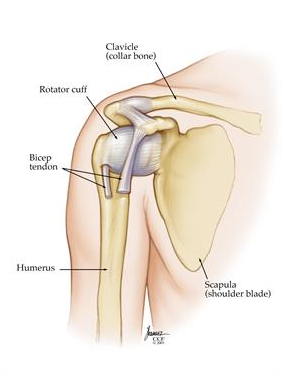| Category | Subacromial Decompression |
Shoulder Impingement Syndrome
Shoulder impingement syndrome is the result of a vicious cycle of rubbing the rotator cuff between your humerus and the top outer edge of your shoulder. The rubbing leads to more swelling and further narrowing of the space, which results in pain and irritation. Treatments include rest, ice, anti-inflammatory medications, physical therapy, cortisone injections, and surgery.
What is shoulder impingement syndrome?
Shoulder impingement occurs when the top outer edge of your shoulder blade, called the acromion, rubs against (“impinges on”) or pinches your rotator cuff beneath it, causing pain and irritation.
What is my rotator cuff and what does it do?
As seen in the illustration, your rotator cuff is a group of four muscles that originates on the shoulder blade and attaches as a “cuff’ of the tendon onto your arm bone (humerus).
You use your rotator cuff to help raise your arm overhead and to rotate your arm towards and away from your body. You will notice in the illustration that the rotator cuff sits in a small space between two bones in the shoulder (the acromion and the humerus). This arrangement makes the rotator cuff susceptible to being pinched or “impinged” between these bones, leading to what is called “impingement syndrome.”

A rotator cuff is a group of muscles that sits in the small space between the acromion and the humerus.
How does shoulder impingement syndrome develop?
When your rotator cuff is irritated or injured, it swells in much the same way your ankle does when it is sprained. However, because your rotator cuff is surrounded by bone, swelling causes other events to occur. Swelling reduces the amount of space around the rotator cuff, leading to rubbing against the acromion. Like a vicious cycle, the rubbing of the rotator cuff tendons results in swelling, which further narrows the space below the acromion. In some cases, bone spurs on the acromion bone can contribute to impingement by causing the space where the rotator cuff sits to be even more narrowed.
Who gets shoulder impingement?
Shoulder impingement syndrome is most commonly seen in individuals who are involved in sports and other activities with a lot of overhead rotational motion – like swimming, baseball, volleyball, and tennis as well as things such as window washing and painting.
Shoulder impingement can also result from an injury, such as a fall onto an outstretched arm or directly onto the shoulder.
How common is shoulder impingement?
Shoulder impingement syndrome is thought to be the cause of 44% to 65% of all shoulder pain complaints.
What causes shoulder impingement?
Your rotator cuff tendon passes through a space below the acromion. The acromion is the bony tip of the outer edge of your shoulder blade (scapula) that comes off the top of the back side of this bone. It meets with the end of your collar bone (clavicle) at your shoulder. Shoulder impingement occurs when the tendon rubs against the acromion.
The causes of this impingement include:
What are the symptoms of shoulder impingement syndrome?
Symptoms of shoulder impingement syndrome include:
Symptoms usually develop gradually over weeks to months.
Shoulder impingement is closely related to other common sources of pain in the shoulder called bursitis and rotator cuff tendonitis. These conditions can occur alone or in combination. Shoulder pain can also be a sign of a more serious injury to your rotator cuff, a small tear or a hole called a rotator cuff tear. If your rotator cuff has torn completely, you’ll likely have significant weakness and may not be able to raise your arm against gravity. In addition, you may have a rupture (tear) of your biceps muscle tendon as part of this continuing impingement process.
How is shoulder impingement syndrome diagnosed?
Your healthcare provider will take your medical history and perform a physical examination to check for pain and tenderness. Your provider will also assess the range of motion of your shoulder and your arm/shoulder strength. They will ask if you are involved in repetitive activities that require overhead arm movement, what remedies you have tried to relieve your pain, prior injuries to the affected arm/shoulder, and any details about what may have caused your shoulder pain and when it began.
X-rays are helpful to rule out arthritis and may show the rotator cuff injury. There may be bone spurs or changes in the normal outline of the bone where the rotator cuff normally attaches. Magnetic resonance imaging (MRI) and ultrasound can show tears in the rotator cuff tendons and inflammation in the bursa.
A diagnosis of impingement syndrome may be made if a small amount of an anesthetic (painkiller), injected into the space under the acromion, relieves your pain.
How is shoulder impingement syndrome treated?
The goal of treatment for shoulder impingement syndrome is to reduce your pain and restore shoulder function. Treatments for impingement syndrome include rest, ice, over-the-counter anti-inflammatory medications, steroid injections, and physical therapy.
Surgery
Surgery is considered if nonsurgical treatments don’t relieve your pain. One surgery called subacromial decompression or arthroscopic shoulder decompression removes part of the acromion to create more space for the rotator cuff. This procedure can be performed arthroscopically, which means through small cuts (incisions) in your shoulder. Other problems with your shoulder can be repaired at the time of surgery including arthritis in the shoulder, inflammation of the biceps tendon, and partial rotator cuff tear. Open surgery, a surgery with a larger cut in the front of your shoulder, is another option.